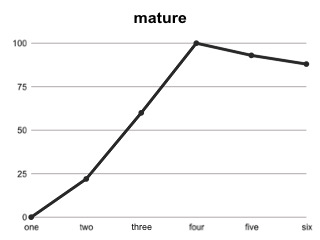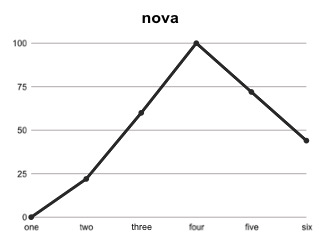(commentary)
Just heard from two different sources deep in the camera companies in Japan. They had the same thing to say: panic seems to be setting in. Everywhere—even though Canon is publicly making the bold claim that their ILC sales will be roughly the same next year (down from their last statement about growing sales this year)—in the back rooms the discussion is apparently now a constant “what’s wrong and why can’t we fix it?" There are big problems and small problems galore, and no one has figured out how to break through and solve them.

What typically happens when a market “matures"
The largest problem is simple: total collapse of the camera market in terms of sales volume (and thus gross sales dollars and profits). This is not the traditional “market matures” type of correction (e.g. first graph, above). The slope of the downward sales trend is far too steep for “market just became mature.” Somewhere we’ve had an ELE (extinction level event) in the camera world (e.g. what I call a “nova” market depicted in the graph, below). It’s just the camera makers can’t seem to find what the extinction event was.

What happens when a market is boom than bust, almost exactly the shape of what’s happening with digital cameras
Smartphones were certainly part of the extinction event. But I’ll repeat my story of Kilimanjaro in 2007: sitting on the sides of the mountain with my brand new iPhone in an area where they had just built a brand new cell phone network was a real Aha! moment for me. Literally, I could take an image and get it to anyone I wanted elsewhere in the world with almost no workflow whatsoever (shoot, open Mail, attach from camera roll, send).
It’s not that smartphones are great cameras, it’s not that smartphones have bigger and better sensors than before, it’s not that smartphones are getting better lenses each generation—none of those attributes about the cameras within smartphones are what is slowly killing cameras. It’s that smartphones are fast, fun, and convenient for dealing with images. Plus the image quality is “good enough.”
The camera makers thought that their way of competing with smartphones was to up the quality (more pixels!, better pixels!, longer lenses!, more lenses! faster focus! more focus options!). But that wasn’t the core of the smartphone users’ complaint about cameras. The primary complaint was much simpler: fast, fun, and convenient. Instant imaging (hey, where have we heard those words before?).
Heck, if you look close enough, you can see that smartphone users are paying more money to have that instant send ability for images (it’s part of the use of their data plan). Doh! “Paying more for less” is always a dead giveaway that something in the market dynamics changed dramatically and needs to be addressed to stay competitive. Heck, smartphone users are updating their phones faster than they’re updating their cameras. Double Doh! And now we have cell providers doing things like rolling over data plans and upping the basic level provided. Triple Doh!
Canon and Nikon are especially vulnerable to the collapsing camera market. Nikon because cameras comprise three-quarters of their sales, Canon because cameras are a big enough percentage of their sales that total collapse would make them a smaller company, too. The panic in these companies is multiple. Besides worrying about declining sales, they also worry that their primary competitor will do something to take more market share, and thus have lower decline than them.
At Canon, which just announced their 2014 financial results, they’re still quite profitable with cameras, but the year-to-year unit volume numbers show severe decline (DSLRs/ILC down 17%, compact cameras down 32%, and those numbers got worse in Q4, the Christmas selling quarter). What’s Canon going to do about that? From their presentation: higher image quality, higher resolution, improved focus speed. Yes, they mention “usability” and “wireless communication,” but there’s no indication that they fully understand how those things are the true driving force if they want to return to growth. For some reason, they also think that adding photography workshops will attract new users. Left unsaid in Canon’s presentation was the usual “cost cutting.” Because there’s no way that profits go up 16% on an overall growth rate of 1% in unit volume as they expect without cost cutting.
Within Nikon, they haven’t announced their latest results yet, but there seems to be a lot of head scratching going on internally over FX. The move to FX was calculated, and tried to hit Canon where they weren’t exactly expecting it. Yet market shares of DSLRs for Canon and Nikon haven’t really changed, despite Nikon’s FX push. The good news for Nikon was that this hid their move from growth to decline quite a bit, as the higher prices of FX products made up for the softening lower end in terms of the numbers that matter most on the financial reports. Still, same market share. That means that both Canon and Nikon are suffering equally now and in the future unless something changes.
Sony apparently has a similar panic to Nikon's. Yes, E and FE cameras are a bit of a success for them. Yet all they really managed to do is shift their historical DSLR market share into about the same ILC market share by shifting sales from DSLRs to mirrorless in the last few years. The good news at Sony is similar to Nikon’s: the lower costs of producing mirrorless versus DLSR, plus the higher prices of the FE cameras, masked the decline in overall volume and lack of ILC market share growth.
Olympus and Panasonic just never got to their promised land in volume before the camera sales declines hit them. Fujifilm and Ricoh at one level don’t care, as cameras are such a small piece of their overall businesses, but I think Fujifilm in particular was surprised that they couldn’t really save their compact camera line and the volume it represented.
So despite several years with plenty of smoke and mirror (whoops, mirrorless) moves, nobody is seeing a truly positive picture forward. Canon’s “flat 2015” is about the most aggressive statement I’ve seen out of the camera makers so far. I pointed out late last year that Sony Semiconductor was predicting an abysmal future for camera sensor sales, even though sensor sales overall is a bright spot for the company. No one—camera company or camera company supplier—is right now seeing a picture of the future that’s rosy. They’re all seeing more dramatic decline, or best case, jogging in place.
Sure, publicly they put on a game face. They talk about some vague future when overall camera sales hit bottom and start growing again. Even a number of the market analysts that follow the industry are predicting that. I just saw another private report this past week that predicted what would be 30% upswing in ILC camera sales by 2018. There’s just one problem with that report: not a single person can tell me why we’d have 30% more buyers in a few years, let alone the author of that report. They can’t point to a camera idea that they think will drive that. It’s as if they magically think that the camera buying public—who’s currently deserting the market in dramatic double digits a year—will suddenly discover their folly and come back to cameras that just have more pixels, more features, incremental performance gains.
Not going to happen folks.
What has to happen is simple, and I’ve been saying it for seven years now: the camera needs to be reinvented. Workflow is a huge part of that.
Maybe I should just stop using the word workflow, because even some of you reading this who have that problem just don’t resonate with that word. How about this: convenience? Substantive improvements in convenience will make me want to buy a new camera. 1.18x more resolution won’t (that’s 50mp versus 36mp, by the way). Heck, even half the weight and size for the same results wouldn’t excite me as much as this scenario:
- Before heading off to Patagonia in March, set my camera to reflect that (file name = YYYYMMDD_Patagonia_SUBLOCATION_SEQUENCE#). Hmm, SUBLOCATION and SEQUENCE# seem to be variables (as is YYYYMMDD, actually). When I move to a new location within Patagonia, I just pick it from a predefined list I made before the trip (I know where I’m going ;~). Better still, the camera uses its GPS or a connection to my smartphone to figure out the SUBLOCATION.
- Whenever I get within communication distance of my computer, the camera automatically moves all files over to the computer. This is verified by the two upon completion of the move, as well. Whenever my portable computer has the bandwidth to do so, it automatically sends a copy of the files to my archive, which lives in the cloud. This, too, is verified. When I get home the laptop automatically moves and integrates my images onto my desktop machine and into my chosen image browser. Status of these things are clearly shown to me on at least one convenient display on the camera, and on the computer.
- When I chimp on my camera, I can start the select/output process by marking these files in numerous ways (selects, send to Facebook, send via email to Mom, etc.). And yes, when those files get to my computer, the things that can and should be done automatically are, and when I ask my photo editing program to show me my current selects, I see just them.
That alone would cause me to upgrade my D810 to a D811, my E-M1 to an E-M2, and so on. It would also be a selling point to the smartphone crowd: want better quality but the same convenience?
Frankly, I’m not sure why the camera companies are in a panic. There’s actually a huge opportunity sitting out there for the one who figures out the real problem and the real answer to it first.





